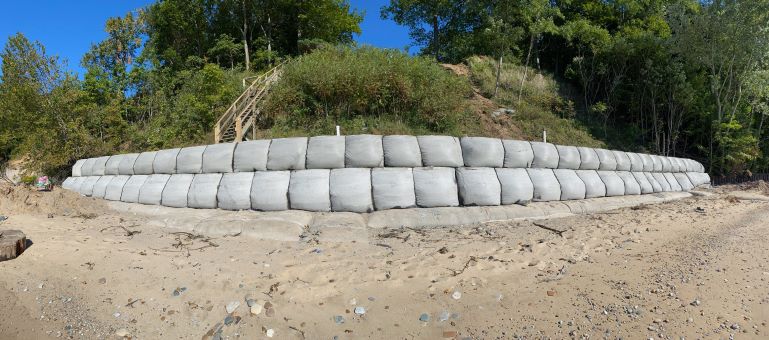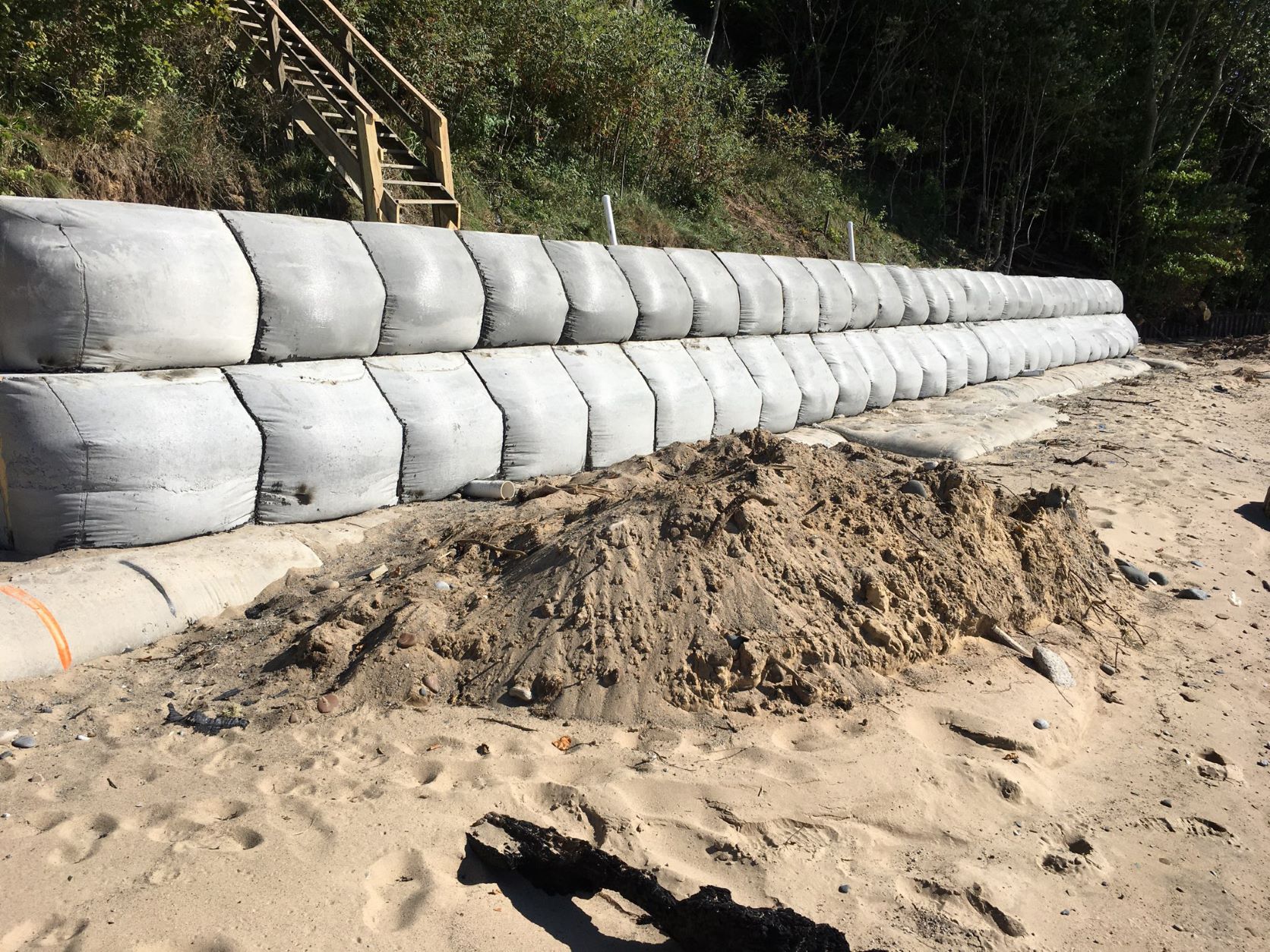MSE Walls 101
TrapBags are rapid deploy flood and erosion control barrier bags. These are used in lieu of conventional sandbags or concrete bags when creating MSE walls.

During the past decades, MSE walls have gained wide acceptance as structures to assist in a multitude of applications. Considering that they have a 95% success rate, this is an overall safe bet.
However, to avoid that 5% chance of failure, it’s essential that you hire a builder that has a grasp on how these walls work. You, too, will want to have a basic understanding so that you can ensure that your wall is exactly as you wish it to be. Read on for a complete guide on mechanically stabilized earth walls, how they are built, and how TrapBags can be used in construction!
 What is an MSE or Mechanically Stabilized Earth Wall?
What is an MSE or Mechanically Stabilized Earth Wall?
An MSE retaining wall is a stabilized earth structure. It is made up of alternating layers of backfill and soil reinforcements. The stability of this soil reinforced wall comes from the fact that there are friction and tension between the backfill and the soil. This MSE retaining wall design works in retaining wall reinforcement to stabilize uneven slopes.
Basically, MSE retaining systems (also known as mechanically stabilized earth systems) serve to keep soil in place on steep slopes. They stop unstable slopes from breaking in by retaining wall reinforcement. The end result is a mechanically stabilized embankment that works as a soil retention structure, containment structure for oil or gas, temporary structure for storage areas or construction sites, or bridge abutment.
If this sounds like something you need, consider reinforced earth retaining structures for a mechanically stabilized earth wall!
What Are the Elements of an MSE Wall?
There are many elements of MSE wall construction so that you can get a wall around earth. To assist you, we have assembled this reinforced earth wall construction manual:
- Have a concept of what you want your mechanically stabilized earth retaining wall design to be
- Choose the MSE zone at which to build an MSE foundation
- Ensure that there is space at this location for your MSE retaining wall design to be realistically built (based on MSE wall panel dimensions)
- Compact and level the foundation (via the process of concrete wall leveling)
- Verify that the soil used for backfill has been tested and approved
- Place the moment slab on MSE wall lifts to ensure appropriate height
- Fill 6″ thick lifts with batter
- Use an MSE wall bridge if there are any gaps between walls
The end result will be a functional wrapped face retaining wall.
Why Do MSE or Retaining Walls Fail?
There are a few potential failures of retaining wall designs that can cause problems if builders aren’t careful. Here, we’re going to look at a few wall failure types to avoid.
The first reason for retaining wall failure is a hole in the wall fail issue. If the wall is not carefully designed and you do not prevent it from retaining wall cracks, you may face cracks spreading and crumbling. This leads to holes in the wall and, ultimately, retaining wall collapse.
Other possible issues that can cause you to fail wall construction are geotechnical engineering failures. Geotechnical failures happen when those responsible for your MSE wall foundation do not adequately ensure that slopes are stable prior to construction. To avoid this, it is crucial to analyze and assess whether or not you have a geotextile retaining wall design before you begin building.
Finally, since water cannot pass through MSE walls, you will need a drainage system. Not having a chimney drain retaining wall will cause pressure to build up behind the structure and lead to bulging and cracking.
Are MSE Walls Vegetated?
If you’re looking to go green, you may be interested in vegetated ecology block retaining walls w geogrid. These wrapped face retaining wall designs are made with geo fabric for retaining walls specifically.
Retaining wall geofabric is made from a geosynthetic material made from polymers. It is installed in horizontal layers between wall segments. It also extends into the soil behind a wall and stabilizes it. This technology is used in lieu of fabrics that are not made with eco-friendly polymers and thus is the superior alternative.
Geogrid fabric for retaining walls are surprisingly easy to install. This makes it simple to create a geo mesh retaining wall. If you are interested in filter fabric for retaining walls and creating a geotextile retaining wall, contact us. Our experts are more than happy to give you more details on installing a geotextile fabric retaining wall.
Can You Stack Bags of Concrete to Make an MSE Wall?
Because conventionally building a retaining wall is a challenge, many people have decided to use building sacks for a bagged concrete construction. This easy retaining wall stacks concrete curing bags like legos at a flex wall angle. This creates a stacked concrete bag wall that fully meets MSE guidelines.
This is called culvert bricking, and it is a simple way to create a sack concrete wall. Do your research and learn some simple tips on how to build a culvert retaining wall before attempting to assemble one.
But which wall is most stable?
It turns out that the concrete bag retaining wall design is more stable than a traditional one. A concrete bag wall is less likely to crack and crumble that a cement retaining wall is. Because of this, using installation bag options are superior.
However, there is yet another superior alternative to a concrete bag retaining wall: TrapBag.
How Are TrapBags Used to Create an MSE Wall?
TrapBag produces inexpensive rapid deploy flood and erosion control barrier bags. These are used in lieu of conventional sandbags or concrete bags when creating MSE walls. They are specially engineered and designed to protect life and property from natural disasters.
TrapBags are easy to use and versatile. You can order them in a variety of different sizes and weights. Once TrapBags are delivered to your construction site, we can offer you assistance in setting them up to ensure that your barrier is effective and that failsafes are in place.
Get Started
While constructing an MSE retaining wall can be a challenge, it’s more than worth it.
Now that you know what MSE walls are and how you can construct one, it’s time to get started. Get a quote for your project and order TrapBag now. Our experts are also happy to answer any lingering questions that you may have about constructing your MSE wall in the simplest way possible.[/vc_column_text][/vc_column][/vc_row]
